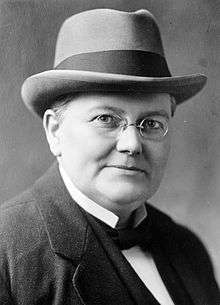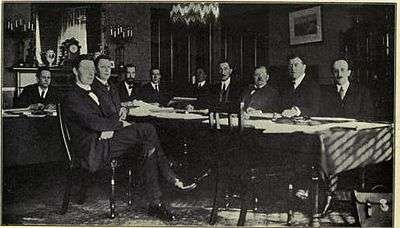Hugh Kennedy
Hugh Edward Kennedy KC (11 July 1879 – 1 December 1936) was an Irish Fine Gael politician, barrister and judge who served as Chief Justice of Ireland from 1924 to 1936, a Judge of the Supreme Court from 1924 to 1936 and Attorney General of Ireland from 1922 to 1924. He served as a Teachta Dála (TD) for the Dublin South constituency from 1923 to 1927. As a member of the Irish Free State Constitution Commission, he was also one of the constitutional architects of the Irish Free State.[1]
Hugh Kennedy | |
|---|---|
 | |
| 1st Chief Justice of Ireland | |
| In office 24 June 1924 – 1 December 1936 | |
| Nominated by | Government of Ireland |
| Appointed by | Tim Healy |
| Preceded by | New office |
| Succeeded by | Timothy Sullivan |
| Judge of the Supreme Court | |
| In office 24 June 1924 – 1 December 1936 | |
| Nominated by | Government of Ireland |
| Appointed by | Tim Healy |
| 1st Attorney General of Ireland | |
| In office 31 January 1922 – 5 June 1924 | |
| Taoiseach | W. T. Cosgrave |
| Preceded by | New office |
| Succeeded by | John O'Byrne |
| Teachta Dála | |
| In office August 1923 – June 1927 | |
| Constituency | Dublin South |
| Personal details | |
| Born | Hugh Edward Kennedy 11 July 1879 Abbotstown, Dublin, Ireland |
| Died | 1 December 1936 (aged 57) Goatstown, Dublin, Ireland |
| Nationality | Irish |
| Political party | Fine Gael |
| Spouse(s) | Harriet Kelly (m. 1898; d. 1936) |
| Relations | Mary Olivia Kennedy (Sister) |
| Children | 3 |
| Alma mater | |
Early life
Kennedy was born in Dublin in 1879. He was the son of the prominent surgeon Hugh Boyle Kennedy. His younger sister was the journalist Mary Olivia Kennedy. He studied for the examinations of the Royal University while a student at University College Dublin and King's Inns, Dublin, and was called to the Bar in 1902. He was appointed King's Counsel in 1920 and became a Bencher of King's Inn in 1922.
During 1920 and 1921, Kennedy was a senior legal adviser to the representatives of Dáil Éireann during the negotiations for the Anglo-Irish Treaty. He was highly regarded as a lawyer by Michael Collins, who later regretted that Kennedy had not been part of the delegation sent to London in 1921, to negotiate the terms of the treaty.[2]
Attorney General

On 31 January 1922, Kennedy became the first Attorney General in the Provisional Government of the Irish Free State. Later that year he was appointed by the Provisional Government to the Irish Free State Constitution Commission to draft the Constitution of the Irish Free State. The Irish Free State was established on 6 December 1922. The functions of the Provisional Government were transferred to the Executive Council of the Irish Free State. Kennedy was appointed Attorney General of the Irish Free State on 7 December 1922.
In 1923, he was appointed to the Judiciary Commission by the Government of the Irish Free State, on a reference from the Government to establish a new system for the administration of justice in accordance with the Constitution of the Irish Free State. The Judiciary Commission was chaired by Lord Glenavy, who had also been the last Lord Chancellor of Ireland. It drafted the Courts of Justice Act 1924 for a new court system, including a High Court and a Supreme Court, and provided for the abolition, inter alia, of the Irish Court of Appeal and the Irish High Court of Justice. Most of the judges were not reappointed to the new courts. Kennedy personally oversaw the selection of the new judges, and made impressive efforts to select them on merit alone.[3] The results were not always happy: his diary, of which some extracts have been published, reveal the increasingly unhappy atmosphere, in the Supreme Court itself, due to frequent clashes between Kennedy and his colleague Gerald Fitzgibbon, since the two men proved to be so different in temperament and political outlook that they found it almost impossible to work together harmoniously.[4] In a similar vein, Kennedy's legal opinion and choice of words could raise eyebrows amongst legal colleagues[5] and fury in the Executive Council e.g. regarding the Kenmare incident.[6]
He was also a delegate of the Irish Free State to the Fourth Assembly of the League of Nations, between 3–29 September 1923.
By-election
He was elected to Dáil Éireann on 27 October 1923, as a Cumann na nGaedheal TD at a by-election in the Dublin South constituency.[7] He was the first person to be elected in a by-election to Dáil Éireann. He resigned his seat when he was appointed Chief Justice of Ireland in 1924.
Chief Justice
On 5 June 1924, he was appointed Chief Justice of Ireland, thereby becoming the first Chief Justice of the Irish Free State. He is also the youngest person appointed Chief Justice of Ireland. When he was appointed he was 44 years old. Although the High Court of Justice and the Court of Appeal had been abolished and replaced by the High Court and the Supreme Court respectively, one of his first acts was to issue a practice note that the wearing of wigs and robes would continue in the new courts. This practice is still continued in trials and appeals in the High Court and the Supreme Court (except in certain matters). He held the position of Chief Justice, until his death on 1 December 1936.
In September 2015, a biography by Senator Patrick Kennedy (no relation) was written on him called Hugh Kennedy: The Great But Neglected Chief Justice.[8]
References
- "Hugh Kennedy". Oireachtas Members Database. Retrieved 7 May 2012.
- Forrester, Margery Michael Collins 2nd edition Gill and Macmillan 1989 p.282
- Hogan, Gerard V. Chief Justice Kennedy and Sir James O'Connor's application Irish Jurist Vol. 23 p.144
- Hogan p.156
- Davitt, Cahir. "Statement by Witness" (PDF). www.bureauofmilitaryhistory.ie. Retrieved 19 October 2017.
- Knirck, Jason (2014). Afterimage of the Revolution: Cumann Na NGaedheal and Irish Politics, 1922–1932. Wisconsin: University of Wisconsin Press.
- "Hugh Kennedy". ElectionsIreland.org. Retrieved 7 May 2012.
- http://www.limerickcity.ie/media/mayr121.pdf
External links
| Legal offices | ||
|---|---|---|
| New office | Attorney General of Ireland 1922–1924 |
Succeeded by John O'Byrne |
| New office | Chief Justice of Ireland 1924–1936 |
Succeeded by Timothy Sullivan |